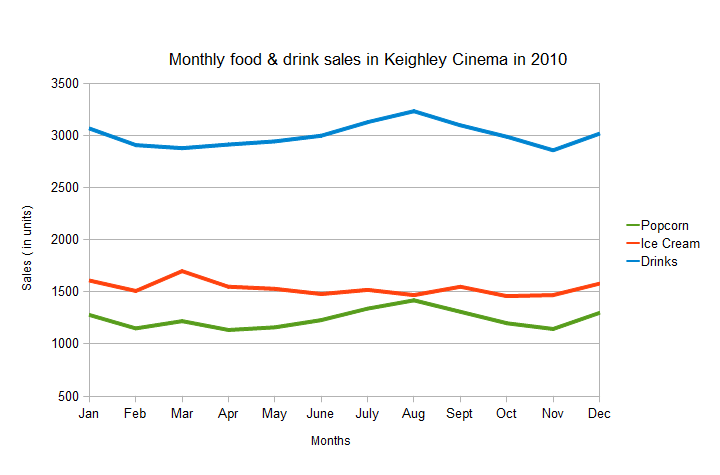Vocabulary for explaining & comparing chart data/trends exercise
Although it is essential to know how to describe the changes in the values of data on a chart (i.e. the increases and decreases) that are used in business reports or presentations, you also need to be able to explain and compare. With explaining, you need to be able to say what the lines/bars and chart represent, and also what the data means or demonstrates. In charts with multiple lines or bars, you will also have to be able to make comparisons between them.
In this online exercise on chart vocabulary in English, we will look at the vocabulary used to both explain and compare data and trends in graphs/charts. Although the focus here is on charts and graphs, much of the vocabulary can also be used for tables.
Exercise: Explaining and comparing a chart
Read the following presentation by a manager about the monthly sales of food and drink in a cinema. Focus on how the Manager explains and compares the data contained in the below chart.
Using the both context and the chart, try to guess what the meaning of the words/phrases in bold are. Then do the quiz at the end to check if you are right.

Manager:'The above chart shows the monthly food and drink sales in the Keighley cinema during 2010. The chart shows unit sales. As you can see, there are three lines on the chart. The sales of popcorn is represented by the green line. The blue line represents drinks. The red line represents ice cream. The chart demonstrates that drinks are by far the biggest type of food and drink sold in the cinema throughout the year.
The chart also shows that there is a correlation between popcorn sales and drinks. When popcorn sales rise, there is also a rise in the sales of drinks. This trend supports the theory that people drink more when they eat food that contains a lot of salt. During the summer, sales of drinks and popcorn showed a steady increase, by contrast, unit sales of ice cream actually fell slightly. In fact, sales of ice cream fell from April to July, falling from 1025 units to 821 units per month respectively. These result would seem to contradict the idea that people consume more ice cream during summer, because as we can see from the results there is no link.
Lastly, the results indicate that during the Christmas period of December to January, people are willing to spend more money. Sales of all three types of products went up during the period. But this could be due to a general increase in attendance at that time of year.'
Quiz:
Below is a definition/description of each of the words/phrases in bold from the above text (which you can also find in the grey box below). Answer each question with one of these words/phrases in bold. Only use one word/phrase once and write it as it is in the text. Click on the "Check" button at the bottom of the quiz to check your answers.
When the answer is correct, two icons will appear next to the answer. The  icon contains extra information about the word/phrase. In the
icon contains extra information about the word/phrase. In the  icon, you can listen to the pronunciation of the word/phrase.
icon, you can listen to the pronunciation of the word/phrase.
Words/phrases to use in the quiz
Practice
Now that you understand the new vocabulary, practise it by creating your own sentences with the new words/phrases.


Follow us on